Ijraset Journal For Research in Applied Science and Engineering Technology
- Home / Ijraset
- On This Page
- Introduction
- Conclusion
- References
- Copyright
A Study on Consumer Satisfaction towards Indian Post Office
Authors: Vimal V
DOI Link: https://doi.org/10.22214/ijraset.2023.52230
Certificate: View Certificate
Abstract
Introduction
I. INTRODUCTION
A. Introduction
The Department of Posts, trading as India Post, is a government-operated postal system in India, which is a subsidiary of the Ministry of Communications. Generally called as "the Post Office" in India. For more than 150 Years the department of post has been the backbone of India’s communication network. After Independence the need for providing communication has doubled across the country. In 1947, there were only 23,344 post across the country out of which 19184 are situated in rural areas and 4160 are situated in the urban areas. But with the rapid rise with the population the demand for post offices has also increased. In light of the increase in pressure the government had taken many steps to the functioning the postal department as the reforms changed from land letters to speed post and these speed post has now a day’s become the speed post.
In the year of 1879 the post cards were introduced while the Indian postal order came in 1930. For faster and precise delivery the Postal Index Number or the pin code was introduced in 1972. In 1977 the department of post introduced value payable post or vpp, parcels, insured parcels. A further more rapid demand and increased stress in communication lead to the division on India Post into the Department of Posts and Department of Telecommunication in the year of 1985. The very next year in 1986 the speed post were introduced. By 1994 you would send to your loved ones living in other parts of the country through money orders.
Post-independence the Indian postal network expanded over 7 times however the postal reforms continued even today. Recently the government has taken several steps to strength the postal department. Project Arrow was introduced in 2008. It aims to create an effective, friendly environment for staff and customers, providing secure IT services and improving mail delivery remittances both electronic, manual and postal savings plans. Then the Mail Network Optimisation Project (MNOP) was introduced with the objective for consolidation and optimisation of Mail Network of department of post, with a view to improve quality of mail operations. Services such as all kinds of letters like speed post, registry, parcels along with track and trade facility for money orders had been expanded and improved. According to government data more than 27200 post offices and administrative offices have been linked to wide area network or WAN. New services like express parcel, business parcel, cash on delivery, online money transfer service and instant money order, e-greeting have also been added. A mobile app has also been launched. The latest reform is the launch of the governments ambitious India Post Payment Banks on the 1St of September 2018. Today one can easy spot a GPS enabled post vehicle on the streets. The department of posts have also started the initiative of the Postal Delivery through GIS mapping in selected cities with an objective to leverage the strength of the vast postal network. The department of post has also started retailing mutual funds and wants. The complexity of the concept of customer satisfaction is motivating researchers and professionals since so many years for innovating new ideas to enhance customer satisfaction. The India Post can leverage its big strength of government support, wide coverage of geographic area and huge customer base.
There are few types of services availed by the Indian Post:
a. Mailing Services: This is the primary work of any post office. They collect, receive, transfer, and deliver letters to the respective address all over the country. There are a few types of mailing services:
- Speed Post: It was introduced in the year 1986. It delivers the mail in less time than compared to ordinary post.
- Business Post: It was launched in 1994 to satisfy the needs of bulk customers.
- Express Parcel Post: It is a door to door delivery. It is reliable and time bound. It is mainly used by the companies who sale the goods based on cash on delivery.
- Media Post: It helps the corporate and government organisation for approaching their potential products.
- E-Post: It was started by 2004. It helps the consumers to send and receive any kind of messages and images through email all over the world.
b. Financial Services: It is the major function offered to the customer. The major source of revenue for the department of post is various schemes of postal banking. The services offered to the customers are public provident fund, postal savings bank account, monthly income scheme, recurring deposit account, national savings certificate, post office time deposit etc.
c. Postal Life Insurance: The postal life insurance was launched in 1884 for the benefit of postal and telegram employees. Later this facility was extended to central and state government employees.
d. Retail Service: This help the common man to avail the facility in their door. Some examples of this service are electricity bill payment, telephone bill, passport application etc.
Thus the Indian Post is offering a wide variety of services because of which a large population of people have become a part of their lives. Every day department of post has managed to service a huge amount of people.
B. Objective Of Study
- To analyse the consumer satisfaction by using Indian Post.
- To recognise the problems faced by the Indian Post due to the emergence of new technology in this era.
- To study the issues the consumer faces while using Indian Post.
- To suggest the measures to improve postal services.
C. Scope
- It focuses on the consumer satisfaction.
- It checks the group of people who depend upon the Indian post.
D. Statement Of Problem
- India post is facing a lot of competition because of technologically advanced competitors. The biggest challenge faced by India post is to sustain in this market and retain the existing customers. In the modern era the customer’s expectations as well as their preferences have changed. Customers are having a plenty of alternatives. So the India post has to adopt the necessary changes to become a leader in the market.
- There is a stiff competition from the private companies, as it is more customer friendly compared to the government owned large organisation.
- There is a lack of internet and mobile services among the rural population.
E. Research Methodology
Research Methodology is a procedure or technique used to identify, select, process and analysis information about the topic:
- Scientific
- Systematic
- Verifiable
Project arrow was introduced in April 2008, by the Indian Post because of which many facilities have been introduced and has been an upgrade in the core function and it makes the post office to look familiar and attract more customers, and it also enables IT facilities to make a systematic transactions and database of the customers for future use. They brought up a new guidelines to process the timeline and dealing with the post offices situated all over the India.
- Data Collection
Data Collection is a process to gather information about the relevant topic of research which is bought by the researcher to answer the questions.
Source of data:
- Primary Data
- Secondary Data
Primary Data:
- Questionnaire
- Observation
- Interview
This study depends upon both the primary as well as secondary data.
2. Period Of Study
The study was done for 3 months
3. Tools And Technique
- Simple Percentage Method
- Weighted Average Method
F. Limitation
- This study is limited to Coimbatore city
- The data’s obtained through questionnaires was assumed to be factual.
- People from urban areas will not have proper knowledge about postal services and various schemes.
G. Chapter Scheme
a. CHAPTER-1: This chapter deals with Introduction and Design of the Study
b. CHAPTER -2: This chapter reflects with ‘Review of Literature’ of the present study.
c. CHAPTER -3: This chapter deals with Profile of Post Office of India – An Overview
d. CHAPTER -4: Analysis and Interpretation of Data
e. CHAPTER-5: The last chapter deals with Findings, Suggestions and Conclusions.
II. REVIEW OF LITERATURE
A. Introduction
Literature reviews is a description of published information in connection with the research. This chapter consists of review of literature related to the consumer satisfaction of post office of government of India. It reviews the current issues in the post office and the change in new technology and the problems faced by them. It mainly focuses on the consumer’s behaviour about the post office. This is followed by highlighting the gaps between the research and contribution of the present study.
B. Reviews
- Hari Sunder G. & Prashob Jacob(2009): In their study researchers had observed the saving habits of individuals in rural area and tried to understand the awareness of people towards post office saving scheme, also examined the perception of investors towards Post Office Schemes. Methodology adopted was simple percentage & Chi-square test. From the analysis it was found that the major purpose of the individual saving was found to be their children’s education and next purpose was for their safety after retirement and the attractive interest provided by the Government. Business persons preferred Bank saving as the best mode of their transactions. Researchers concluded with the suggestions as for India Post, there is no alternative than to leverage its infrastructure, trust, and related services into a much larger role in e-commerce & e- Government. Government must create more awareness among rural and urban people about the saving schemes and benefits available through it.
- Shubhda Mohan Kulkarni (2010)in this study there is a need of change with changing business environment in Postal services for sustainable development of post offices in India. It highlights on Customer satisfaction and technology up gradation. Researcher has also thrown light on an initiative to transform India post into a vibrant and responsive organization has been taken under the project arrow in which modernization of post offices is under process. Further she has pointed out the need of product diversification and innovation in services. She has concluded with a suggestion of modernization and marketing of postal services for sustaining in the Globalization.
- Mu Subramanian (2010)the study highlights in his paper the importance of training the employees in the department of post. Training must be given in all fields as it prepares them to face any kind of challenge and opportunity in their own way. The focus is on the improvement of quality, and continuously it must be improved. Indian post has adopted the AIM model- appraisal, intervention and measure model to enhance the quality.
- Balasubramanian (2010) in this study the innovative services provided by Indian post to the rural masses of India like multilingual information kiosk, with the help of Microsoft services is described and the benefits of the services to the rural postal customers are elaborate. The central data base is developed and centralised content management system been developed with the new software’s which are multilingual and it will be useful to get informed in local language and will increase efficiency in postal services and reduce cost and increase competitiveness.
- Kawaljit Singh (2011)The study has been designed so that even the rural population can understand easily the main features of small savings scheme and the goal of financial inclusion of government. It contains information about the saving deposit account, about the procedures of Savings Bank A/c, and also the opening transaction of savings bank A/c. It also deals with recurring deposit account, time deposit account, wages account under MG-NREGA, monthly income account scheme, senior citizen saving scheme and its account operating procedure, PPF scheme, National savings scheme About Kisan Vikas Patra (KVP) , National Savings Certificates VIII, the fees charged to various schemes by post.
- Rajeshwari and K.J. Sunmista(2011) They states in their paper comparisons of consumers perceptions of service quality of Post Office in Virudhunagar District and Madurai District. Customers have a positive attitude more than the negative attitude towards services of Post Office. The Respondents are satisfied with their services and schemes.
- Ritika Agarwal (2012) Concludes in her study that various factors which focus on influencing the investors to invest among the different savings scheme provided in the post office. She also explains that the educational qualification and occupation of the investor has a significant impact on the savings pattern and also the scheme that they are going to choose that is available in the post office. The senior citizen scheme are preferred by very low people and communication network of the post office should be increased. Post office provide a good bundle of savings product. Revolution in IT sectors have been the most challenging for the postal offices.
- M.K Gupta and Nidhi Gupta (2012)the study tell the customer satisfaction plays a successful role in company. The paper studies the satisfaction of the customer that they get from the services provided by banks and postal office. Post offices provide a better and competitive service as compared to banks. They should improve the infrastructure and use latest technology so that everyone would prefer post office rather than banks. They should have god and fast grievance handling system and should also provide discount to the customers.
- Aditya Krishna (2012) researcher has focused on two main postal aspects of Post Office Act 1889 and the proposed draft of post office bill 2011 Extending and maintaining an essential postal infrastructure (network). Researcher has Highlighted concerns of services providers and consumers. Which recommends restructuring of postal services in the light of experience of other countries in the world of regulatory, architecture for other network industries (Private courier services Industries).
- G.Thangapandi (2013) according to his study, post office provides numerous studies to the economy. The objective is to access the opinion of the customer towards postal services and how frequently they use those services. Some suggestions must be offers for improving them. The focus is on the demographic profile of the customer namely literacy, occupation, and their location. And no changes has been observed in the name, age, income of the person.
- Mehul Chandrakant Chhatbar (2013) tried to explain in his study the satisfaction of consumers which they derive from using services of post and in comparison with the satisfaction they get from private courier services in Mumbai. The study reveals that there is no significant difference in the satisfaction difference in the satisfaction levels of the consumers. The post office provide excellent and better services at low cost than compared to a private courier services and also private courier provide a more prompt services at a higher price. Therefore, he concludes that the customers are satisfied with both the private courier and the Indian postal services.
- Dipankar Malankar (2013) he tries to explain in his study the satisfaction of consumers which they derive from using services of the post offices and in comparison the satisfaction arrived from private courier services. The study reveals that there is no significant difference in the satisfaction levels of customers. A post office provides excellent and better services at low cost whereas private firms provide prompt services at little high cost.
- K. Gayathri (2014) according to the study, the general attitude of the investors towards the different scheme with the postal services in cumbum town. It analysis the various problems faced by the customers in investing money in post office. It also highlights the suggestions to be made in improving the post department and their services. Upgradation of latest technology will make services faster and reliable. There is lack of awareness is there so advertisement strategy should be used. Post office will reach to millions of people serving the best products and scheme. Its plays a huge role in rural areas.
- Ashok Bahadur Singh (2014) This study examines the feasible model of mobile banking based money order by integrating Indian Post with banking sector and find out the factors that drive inhibit the demand potentials of such services. The study has identified certain factor for demand of mobile money order for deploying the mobile money order, which can provide an opportunity to Banks and Indian Post to accelerate the business growth.
- Suman Mathew (2015) include in her study the role of postal administration in providing the excellence services and enjoying the trust in customers. The Indian post must enter into new areas like telephone and financial service. Indian post is the largest and most creditable outreach infrastructure in the country. New methods of delivery of letters and parcels. Its core competence are creditability, brand strength and outreach to millions of people.
- B. Saranya and G.B.Karthikeyan (2015) the importance of savings among the investors in post office scheme. To analyse the satisfaction they derive using the services of post office and to analyse its strength, weakness, opportunity, threats. Therefore, the primary reasons for investors to invest are emergency needs, family needs and future of children.
- Mohammed Rafee (2015) in this study he highlights the changing face and role of post offices in Indian Sector. India has the largest postal network all over the world. It plays a very crucial role in socio-economic development. It also tells the various suggestion for Indian Post to provide better services to the people. Therefore, there must be some changes to be made in the post.
- Ravindran (2016) in this study they reveal that post office is not only medium of sending letters but also give multiple financial services to the public. Some of the services they provide are sending money to foreign, postal life insurance, mutual fund investment and small savings scheme. Also women can be attracted by giving them right information and knowledge about the post office and their schemes provided.
- Bhagyashree Teli (2017) in this study people living in Rajsamand district, stated that people knew about the post office deposit scheme through their friends and relatives. There was a lack of awareness about the post office except the recurring deposit and post office savings bank account. He also tells that small savings is good in post office but there must be awareness through the advertising agents.
- Vembu (2018) according to the study, it revealed that more of the rural women are interested in savings their amount in post office savings scheme because of the post office is situated near their residing location. The post office officials create awareness to rural people for investing their money in post office. So that it would create growth for postal sector.
- Rameshkumar (2018) this study mentions the importance of post office in India. There must be proper savings done by everyone to meet their tomorrow’s needs. It also focuses on the rural working women’s and their attitude towards the post office schemes. It is an easy process as compared to the making investment or an opening a bank account and depositing it. Even the women’s have great faith and positive attitude towards post office savings scheme.
III. POST OFFICE OF INDIA- AN OVERVIEW
A. Post
Indian postal system was for military and governmental communications. It was developed long before the arrival of Europeans Indian Post was established in 1837. The Indian postal system developed into an extensive dependable and robust network providing connectivity to all parts of India, Burma and other areas controlled by the East India Company (EIC). Effective postal services were provided at low cost. After the Independence of India on 1947, the Indian Postal Service continues to function on a countywide basis and provides many valuable low cost services to the public of India.
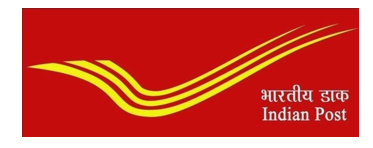
- INDIAN POST
It was formed on 1st October 1854. It has been 166 years since it was formed. Its headquarters is in Dak Bhawan, Sansad Marg, New Delhi. The minister responsible for this department is Minister for communication. They also have introduced website www.indiapost.gov.in. These Indian Post are involved into delivering mail, remitting money by money order, accepting deposit, providing life insurance coverage. The country has been divided into 23 postal circles, each circle headed by a Chief post Master general. These circles are divided into regions headed by the post master general and comprising field unit known as division. These divisions are further classified in sub-divisions.
B. History Of Indian Post, How It Came Into Force
In 1296 horse and foot postal was first introduced and that was the very first kind of post in India. People used to travel with horses for miles together for delivering a particular message. This used to take a long time to reach. In the year of 1766 Robert Clive (the first British Governor of the Bengal Presidency) sets up a regular postal system. In 1774, Warren Hastings organises the Post Office. On 31st march 1774 in Calcutta GPO (General Post Office) was set up. On 1st June 1786 Madras set up a GPO. In 1794, Bombay also opened GPO. In 1850 Post Office Commission was appointed. In 1860 Postal Manual was published. Embossed envelops were put on sale in the year 1873. In 1876, India joined the Universal Postal Union. From 1878- 1880 Post cards were introduced and railway mail services were launched. Savings banks were opened in Indian Post in the year of 1882. Postal life insurance came into force from 1884. Sale of One-Anna revenue stamp was started in the year 1886. Post office Act VI was introduced in the year 1898. In December 25, imperial penny postage was introduced. The very first stamp of Independent India was issued on 21st November 1947. It depicts the Indian flag with the patriot’s slogan (Jai Hind) on the top right hand corner. In 1947. A memorial to Mahatma Gandhi was issued on 15th August 1948 on the first anniversary of independence. In 1955 technology and development theme that shows the map of India in 1957. The old inscription of India Postage was replaced in 1962 with Bharat India through 3 stamps issued from December 1962 to January 1963. On 1st August 1986, Speed posts were first introduced. In 1994, express parcel came into force. On 25 June 2006, e-payment services got introduced. In 2008, modernisation of post office was done that is Project Arrow was introduced. This project was started to transform Indian Post into a vibrant and responsive organisation. It must be benefitted to the customers and to modernize the post. It also upgrades the post office in rural and urban areas and its quality of services and also improves the look and feel of the post office. It aims to create a conductive for both the staff and customer visiting the post office. In 2012, IT modernisation project was introduced.
- Vision: India Post will be a socially committed technology driven, professionally managed & forward looking Organization.
- Mission: To provide high quality mail, parcel and related services in Indian and throughout the world; to be recognized as an efficient and excellent organization exceeding the expectations of the customers, employees and the society to perform the task.To sustain its position as the largest postal network in the world touching the lives of every citizen in the country. To provide mail parcel, money transfer, banking, insurance and retail services with speed and reliability.
C. PIN
The postal Index Number (PIN) is a six digit postal code. The PIN system was introduced by Shriram BhiKaji Velankar when he was at service in Kolkata. Former Prime Minister Indira Gandhi introduced it on 15th August 1972. There are 9 postal zones. Out of which first 8 are geographical region, and the ninth is reserved for Army Postal Service. The PIN system is organised in the following manner:
- The first digit indicates the zone.
- The first two digit indicates the sub-zone.
- The first three digit indicates a sorting district.
- The last three digit indicates the delivery post office.
D. Project Arrow, 2008
Indian post has undertaken a quality improvement project called project arrow to transform India post into a responsible organization. This was launched in April 2008. It mainly focuses on the look and feel of the people visiting the post office. Enhancing the quality of services in core areas and focuses on Mail delivery, money remittances, and savings bank. The monitoring of core areas has been extended to more than 18,600 computerized post office. Look and feel has been improved in 1736 post office across the country.

- Conceptualizaion Of Project Arrow
a. Present Scenario
- 70% of India’s 1.1 Billion people live in Rural Areas.
- Most Villages and small towns do not have enough Connectivity\Outlets to the mainstream economy
b. Potential Of Indian Post
- Indian Post has over 1.55 lakh post offices across India, with more than 1.25 lakh in Rural areas
- This Vast Network provides a huge opportunity to connect remote areas with the mainstream.
2. Objective of the Project Arrow
- To make post office in rural areas a place for availing services
- They mainly focus on ordinary people in the country.
- To enable post office to play a large role in the social and economic transformation of the country.
3. Advantages of Project Arrow
- To upgrade the appearance of post offices to a unique identity.
- Simpler and faster money transfer through web based remittance.
- Online public grievance handling and timely settlement of complain.
Project arrow experience is a working model for improving in the postal system. And it was also awarded with “Prime Minister” award for excellence in public administration for 2008-2009 in 2010.
4. Project Covers 8 Silos
- Mail Delivery: Ensure same day delivery of mail received and same day dispatch of mail collected.
- Savings Bank: Reduce transaction time at counters and for account transfer or closure settlement of deceased claim cases.
- Office Service Level: Improve customer satisfaction along all parameters from appearance to operations
- Remittances: Delivery of money orders on the day of receipt and providing web- enabled remittance services
- Human Resources: Identify roles and job descriptions for all and design suitable training packages to enhance operational and soft skills of staff
- Infrastructure: Develop standardised and consistent interior and exterior blue print and ensure uniform implementation
- Technology: Decide an required hardware, software and connectivity to enable post offices to provide all IT enabled services even in Rural areas
- Branding: Ensure uniform brand hierarchy as well as consistency for all products and services.
5. Project arrow revenue earned:
The Information available through the web based Data Extraction Tool (DET) through which Project Arrow post offices are monitored by the Department of Post, has reportedly revealed an increase in revenue generation in respect of major transactions and operations such as postage realized in cash, Money Order and Indian Postal Order Commissions, Postal Life Insurance, Rural Postal Life Insurance Premium, Electronic Money Order, e-payment Commission, postal stamps sales revenues, publication sales, revenue from other mail services and revenue on account of increased number of savings bank accounts.
The Department of Post has also informed the Committee that the total revenue in respect of 1724 Post Offices covered under Project Arrow has increased from 1345.82crore in 2010-11 to 1595.54crore (18.55%) in 2011-12 and to 1800.69crore (12.86%) in 2012-13 respectively.
When inquired about the decline in growth rate in the revenue earned by the Post Offices under Project Arrow, the Department of Post in its Post Evidence Replies has submitted as follows:
As per the information available through the Data Extraction Tool, the revenue trend of 1724 Project Arrow Post Offices shows the aforesaid increase. But, 2012 onwards Department has launched new premium products, financial services, International Money remittances, electronic franking machine facilities etc. and set-up a large number of Business Post and Logistic Post centre for handling bulk business. Thus, the revenue which was accounted earlier at these 1724 Project Arrow Post Offices is now being accounted at these Business Post Centres and Logistics Post centres. The overall growth of revenue of the Department has been 17% from 2011-12 to 2012-13. The Outcome Budget (2013-14) of Department of Post states that the challenge of providing cost effective and valuable services to the customer is also a matter of constant concern. The total revenue during 2011-12 was 7899.35crore against net working expenses of ` 13,705.27crore leaving a gap of 5805.92crore. The increase in postal revenue over the previous year was 13.46 % and decrease in deficit 8.51 %.

E. Customer Satisfaction On India Post
The concepts of marketing have changed over the period of time. Due to the evolution of information technology, modernization and globalization of business, the marketing today has become more customers centric. The customer is the king of the market hence is really indispensible for the companies to recognise the value of the customers. The customer is considered as the most valuable asset of the company which needs to be maintained properly for raising the market share. Hence it is crucial to meet the necessary expectations of the customers and keep them happy. Thus the customer satisfaction is a critical factor in the marketing philosophy. The customer satisfaction is an abstract and ambiguous concept. It is a psychological phenomenon. It is a feeling or expression which an individual derive after using a product or service. It is an attitude of a customer which depicts what the customer feel about the organization. When the product or service supplied by an organization meets or exceeds the expectations of the customers the customer is said to be satisfied.
- Indian Post Customer Relationship
Prompt, reliable delivery & Courteous service – Most important factor for Customer Satisfaction
a. Customer Service with Indian Post:
- Satisfaction Levels is Higher for Private players vis-a Indian Post.
- Number of users who have expressed dissatisfaction towards extremes in Higher in Indian Post.
b. Service Quality Dimensions
- Reliability: Ability of Indian Post to perform promised service dependably and accurately.
- Responsiveness: Willingness of Indian Post personnel to help customers & to provide prompt service.
- Assurance: Knowledge & Courtesy of Indian Post & its personnel to inspire trust & confidence.
- Empathy: Caring & individualized attention that Indian Post should provide its Customers.
- Tangibles: Appearance of physical facilities, equipment, Personnel & Communication material.
F. Postal Services
Operations at the Post office encompass the entire range and scope of the basis of Postal Services which include:
- Sale of Stamps and stationery
- Booking of Registered Articles
- Booking of insured Articles
- Booking of Value Payable Articles
- Remittance of Money through Money orders and Postal orders
- Booking of Parcels
- Savings Banks and Savings Certificates.
- Post Office Bill 2011
Postal department has drafted a post office bill 2011 in replacement of Post Office Act 1898 and has sent to the cabinet for approval. The purpose of providing protection to the department of posts is to compensate it for the services provided by them in rural areas. The department runs many Post Office in small villages but the business is less and the cost of running them is high. On the other side, the courier companies mainly serve a large volume in the cities. The reason for this problem is that technological developments have made postal service outdated. They also have asked the private operators to charge twice the speed post tariff so that everyone would opt the postal services given by the government and there will be some kind of revenue for the government to run these postal services.
2. Postal Packing Parcels
A parcel should ideally be packed and enclosed in a reasonably strongcase wrapper, or cover fastened in a manner calculated to preserve the contents from loss or damage in the post, to prevent any tampering therewith, and to protect other postal articles from being damaged in any way thereby. If a parcel contains cloth or woolen material it must be packed in a strong wrapper with an outer covering of stout card-board or cloth. It is suggested to use a wooden or a stout cardboard case according to the nature of the article for packing a parcel.
Liquid and substances which liquefy easily must be dispatched in a double receptacle. Between the first receptacle (bottle, talks, box etc) and the second (which must be a box of metal or strong wood) some space must be left to filled with saw-dust, bran or some other absorbing material in sufficient quantity to absorb all the liquid contents in the event of breakage.

Live-bees must be enclosed in suitable cases and so packed as to prevent all risk of injury to other postal articles in course of transmission by post or to officers of the Post Office.
3. Postage Stamps Of India
India has a long and varied Postal history and has produced a large number of Postage Stamps. These have been produced by a variety of techniques including line engraving, typography, lithography, photogravure and web-offset. Stamps have been produced both for postage and for service or revenue. Definitive and Commemoratives have been issued. Stamps have been produced both as un-perforated sheets, perforated and miniature sheets.
Perfin Define: A Perfin is a number of small holes in a distinct pattern applied to stamps as security against theft.
The Name Perfin is a condensed form of PERF orated Initials, or PERForated INsignia.
Other security endorsements on Stamps included commercial overprints (on stamps used fiscally) and under prints.
The Indian Postal Service has been issued stamps on many themes – relating to history, architecture, nature, culture and heritage. Provisions exist for organisations and interested bodies to suggest the printing of special commemorative stamps as well as first day covers and cancellations. The Indian Post runs Philatelic bureaus, operates deposit based on philatelic services, a philatelic magazine and publishes list of stamps from time to time.
4. Types Of Postal Stamps
There are Six types of Postal Stamps are in circulation are,
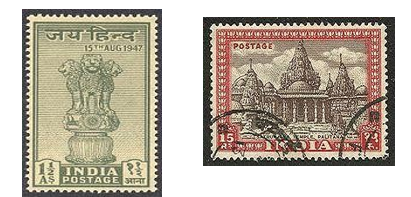
- Commemorative Stamps:A Commemorative Stamps is often issued on a significant date such as an Anniversary, to honour or commemorate a place, event, person, or object. The subject of the commemorative stamp is usually spelled out in print. There are numerous commemorative stamps that were issued by India to honour notable personalities like freedom fighters, politicians etc. Many other stamps to celebrate special events related to sports, space, science and technology, defence, arts and crafts etc. are issued.
- Republic Definitive Stamps: These stamps are a part of the regular issue and are available for using postage services for an extended period of time. They are designed to serve the everyday postal needs of the country. A definitive issue or series have a range of denominations sufficient to cover the ongoing postal rates. Several definitive stamps of India have been issued with different themes and illustrations, depicting art, history, science & technology, nature, vehicles, industries, institutions and more.
- Military Stamps: During the time of war or when peace keeping operations are on, special postage stamps have been issued called as military stamps. Mostly the army itself transports the letters to the desired destinations. These stamps were commonly used during World War II by soldiers who wanted to connect and then send their message across to their beloveds. Prior to that and since that, many other military stamps of India have been released for various military operations where Indian Army has made some selfless contributions. These stamps portray different monuments, culture, arts and crafts, personalities and more. The stamps are overprinted to use in foreign on regular definitive stamps by Peace-keeping Armed Forces.
- Miniature Sheets: A Miniature is a small group of stamps that are still attached to the sheet on which they are printed. They could be regular issues or commemorative ones as well. They could be individual designs as well with special illustrations on the sheet. Several miniature sheets have been issued by India which portrays different aspects of the nation’s identity like famous personalities, important events, art and culture, history, monuments etc.
- Se-Tenant Stamps: Se-tenant stamps are printed on the same plate and adjoin one another. Though they make a set of which adjoin each other on the same sheet, there designs colour, denominations or overprint differ. They may also feature overlapped or extended designs which appear on the entire set of stamps. India has a tradition of releasing some extremely beautiful se-tenant stamps that collectors all over the world love to own.
- My Stamp: My Stamp is the brand name for personalized sheets of Postage Stamps of India Post. The personalization is achieved by printing a thumb nail image of the individual photograph and logos of institutions, or images of artwork, heritage buildings, famous tourist places, historical cities, wildlife, other animals and birds etc., on a selected template sheet having Postage Stamps. ‘My Stamp’ was first introduced in India during the World Philatelic Exhibition, ‘INDIPEX-2011’.
5. Different Saving Product Of Indian Post Office
a. Post Office Savings Bank Account (POSB): It’s the oldest and most popular postal savings instrument. Any individual can open a POSB account with minimum balance of Rs, 50. Currently the rate of interest offered against POSB Account is 4%. It’s regulated by the Government Saving Banks Act of 1873.
b. Recurring Deposit Account (RD): Offers a monthly investment option with a handsome return at the end of five years with option to extend the account period. The Present rate if interest rate for RD IS 8.4%. Premature closure is allowed after three year and part withdrawal is also allowed. Four defaults are allowed. Depositor are provided with one Passbook.
c. Monthly Income Scheme (MIS): Offers a fixed investment option for five years with a monthly interest payment facility. The facility of automatic credit of interest to SB Account is available. Single Depositor is Rs1000 and in case Joint Depositor is Rs1500. Maturity Period is five years and rate of interest is 8.5%.
d. Public Provident Fund (PPF): Offers intermittent deposits subject to certain limits for 15 years period with income tax exemptions subject to certain conditions on the investment, loan and withdrawal facilities also available. Tax advantage scheme with 15 years scheme with a minimum deposit of Rs500 in a financial year of maximum Rs. 70,000 per year. Interest is allowed at 8.8% per Annum.
e. Time Deposit (TD): Post office offers time deposit for one year, two year, three year and five year. The rate of interest is allowed is 8.2%, 8.3%, 8.4%, 8.5% for term deposits respectively. Minimum deposits 200 and no maximum limit. Premature withdrawal is allowed after expiry of six month. Automatic credit facility of interest to SB Account.
f. Senior Citizens Savings Schemes(SCSS): Offers Fixed investment option for senior Citizens for a period of Five years, which can be extended, at a higher Rate of Interest that are paid in Quarterly Instalments.
IV. ANALYSIS AND INTERPRETATION OF DATA
Analysis of data is a process of inspecting, cleansing, transforming, and modeling data with the goal of discovering useful information conclusions and supporting decision-making. Data analysis is a process for obtaining raw data and converting it into information useful for decision-making by users. Data are collected and analyzed to answer questions, test hypothesis, or disprove theories.
Statistician John Tukey defined data analysis in 1961as: “Procedures for analyzing data, techniques for interpreting the results of such producers, ways of planning the gathering of data to make its analysis easier, more precise or more accurate, and all the machinery and results of statistics which apply to analyzing data”.
The following tools were used:
- Percentage Method.
- Weighted Average Method
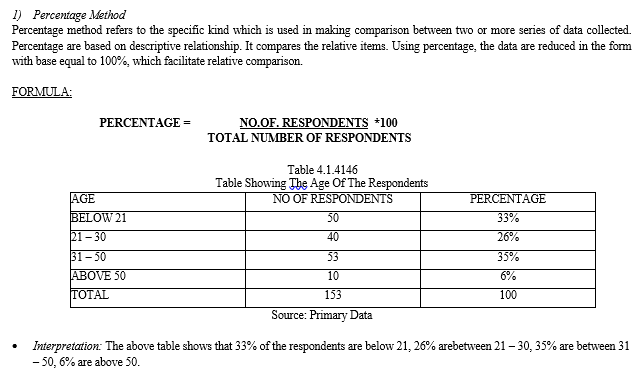
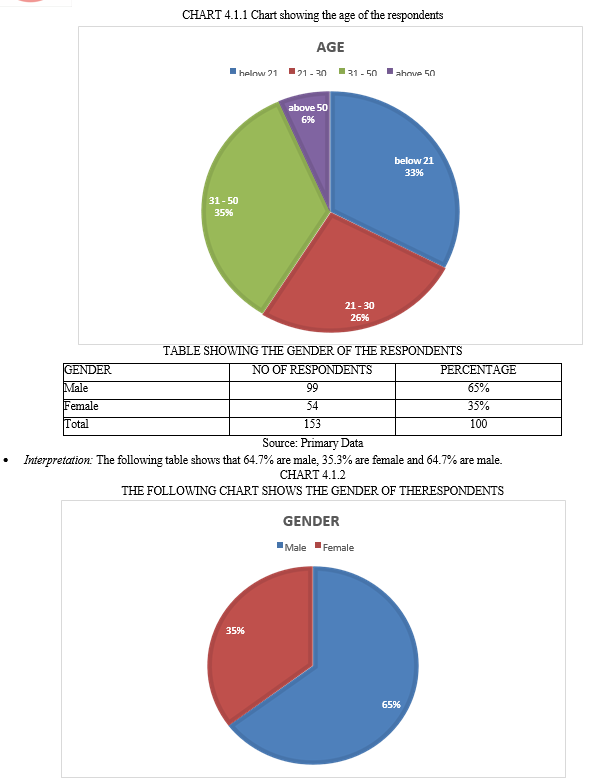
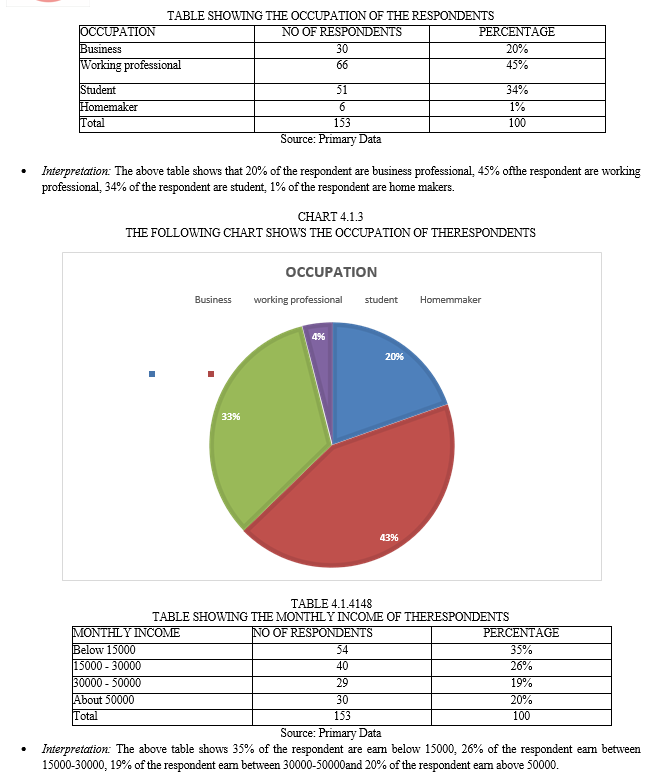
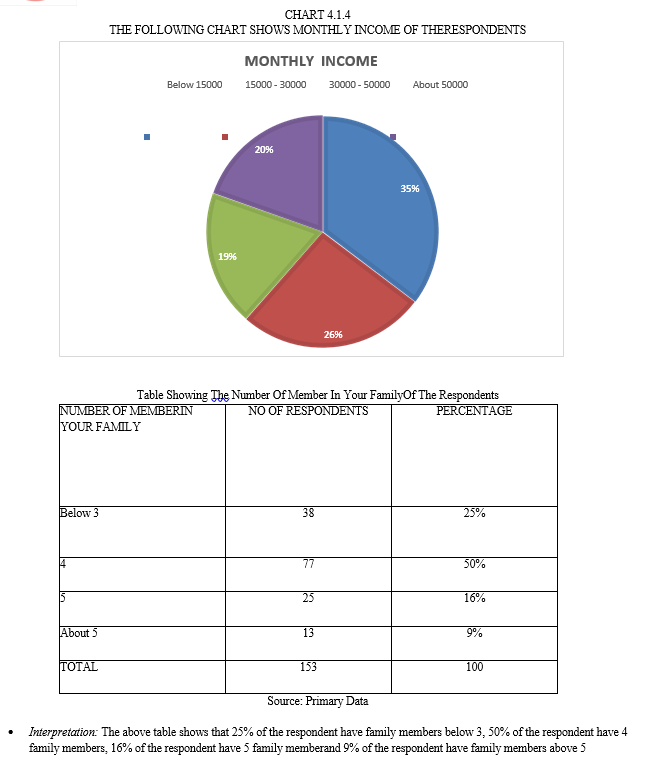
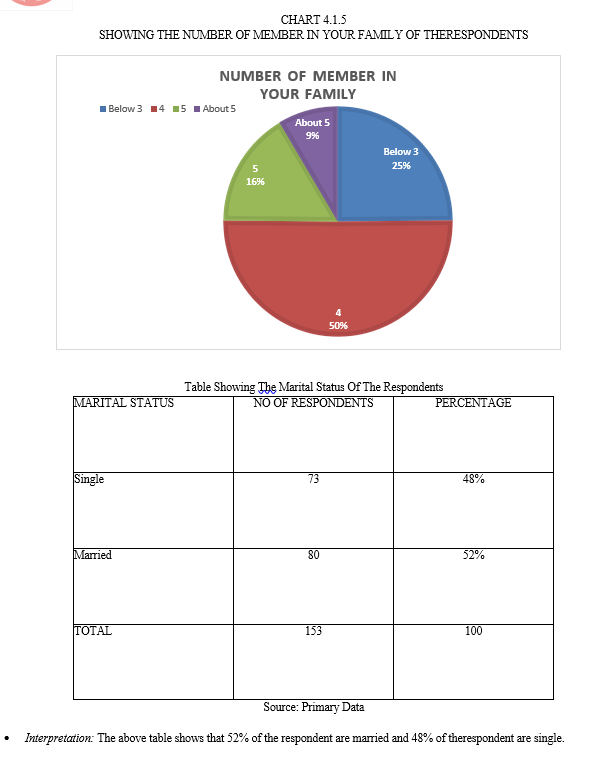
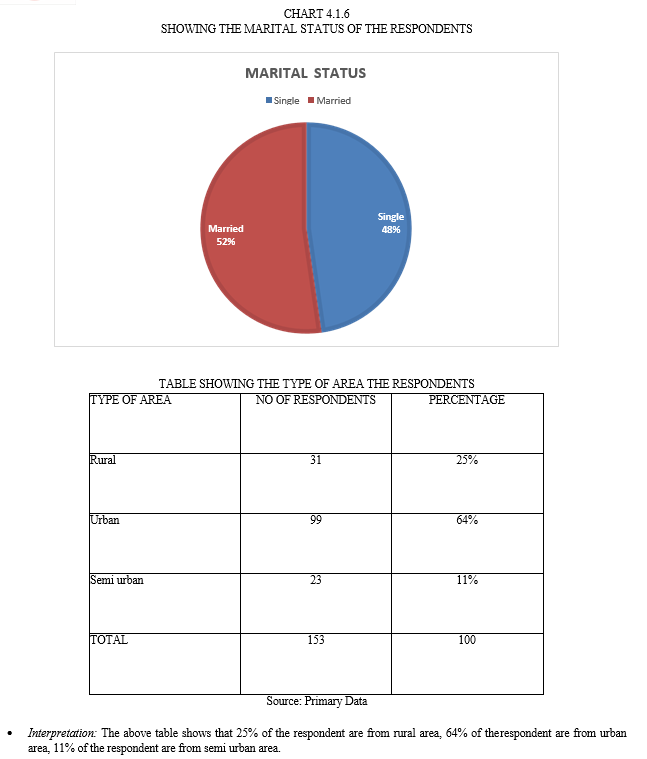
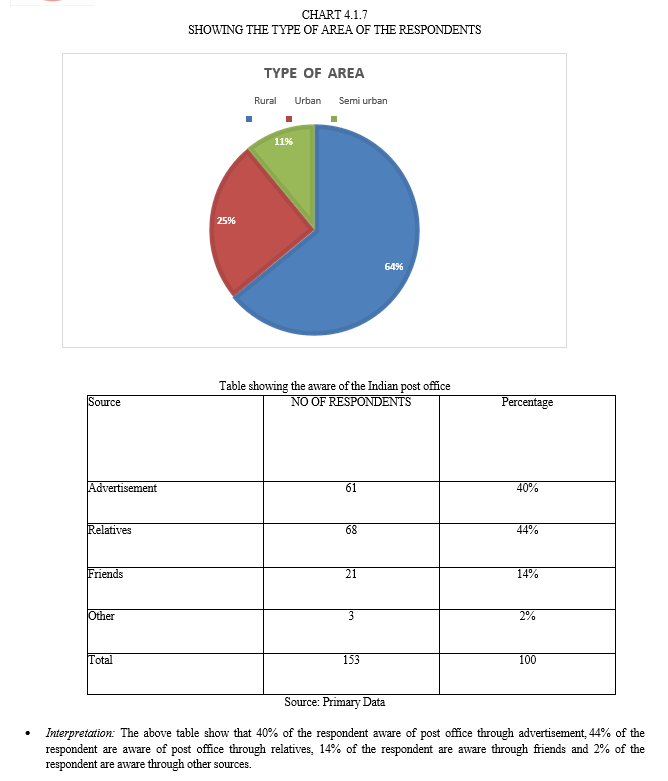
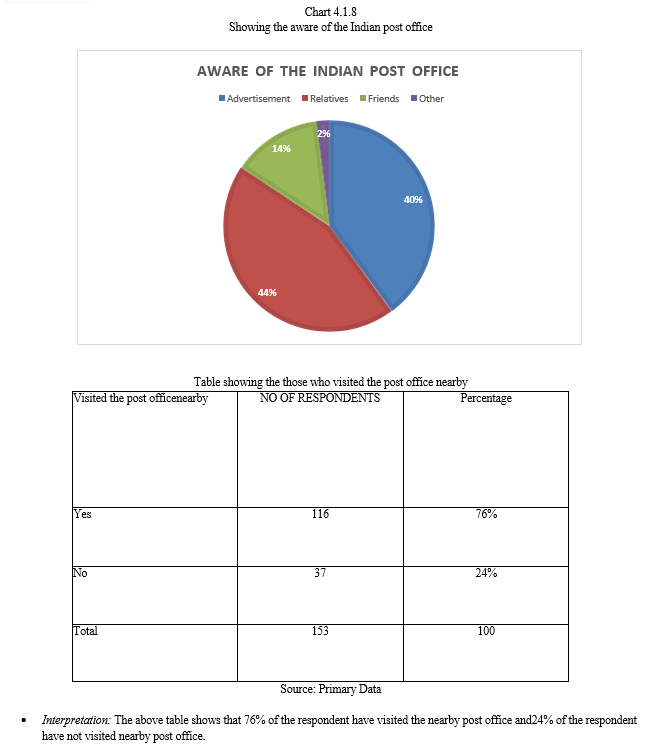
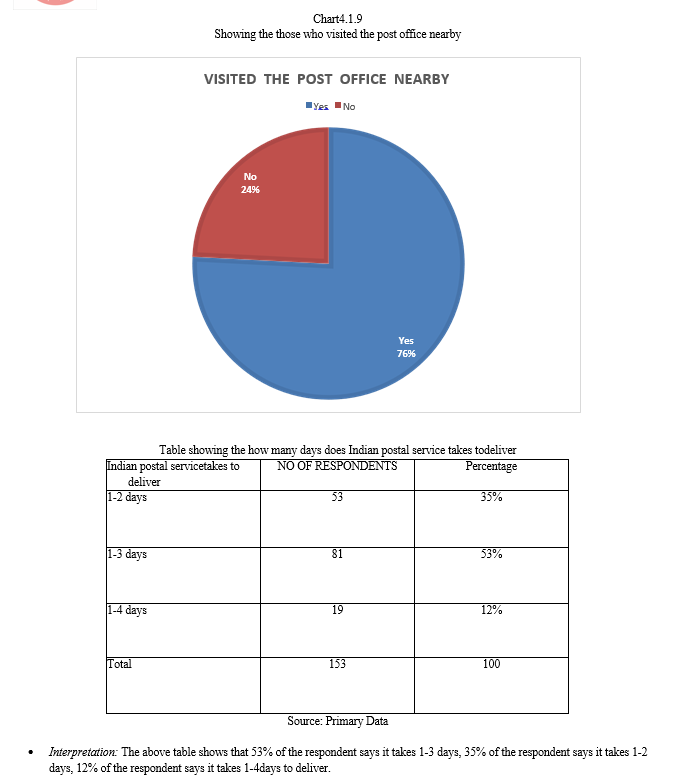
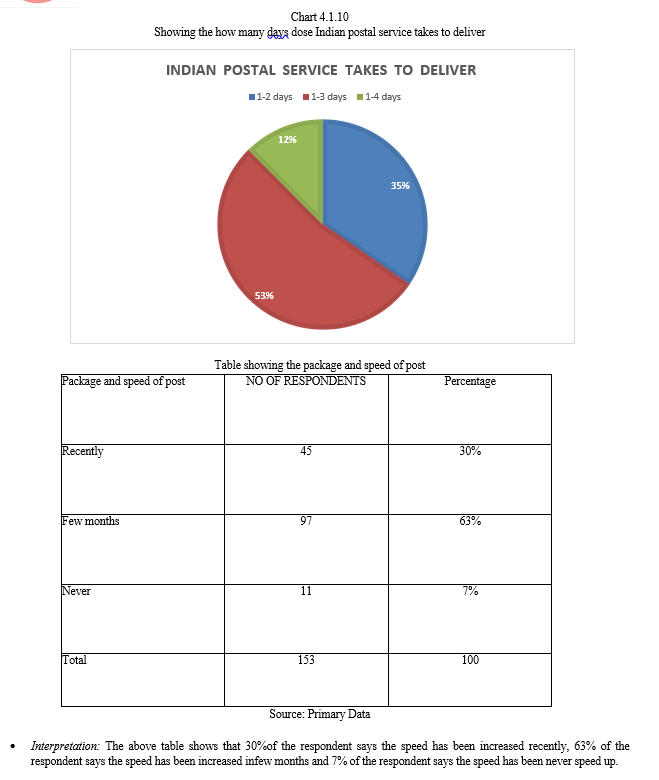
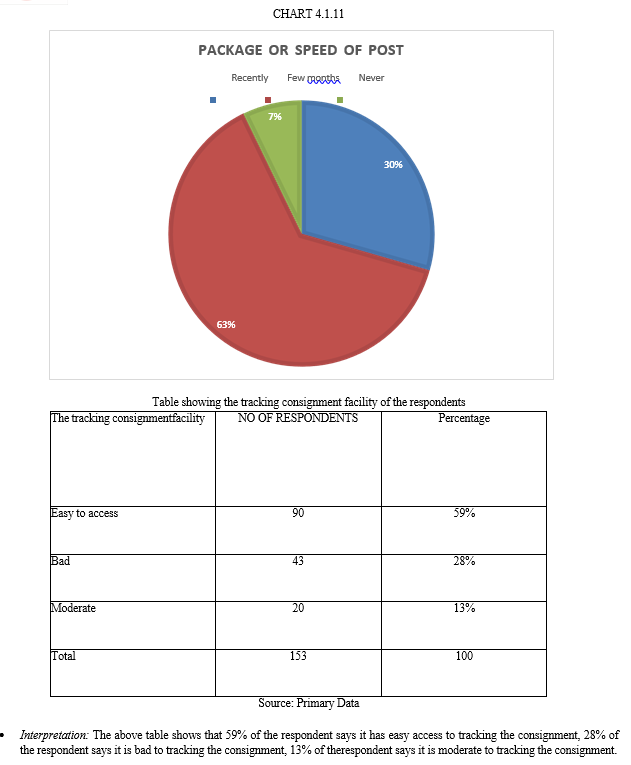
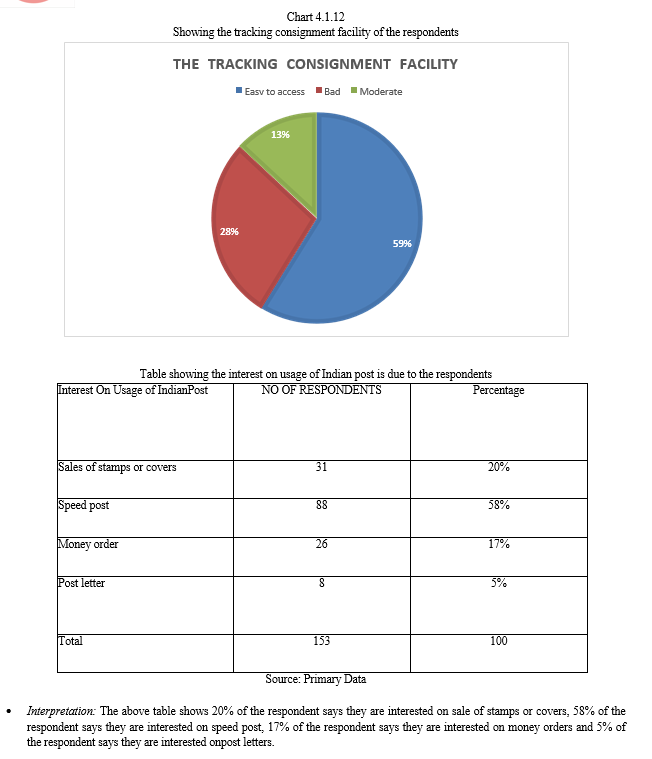
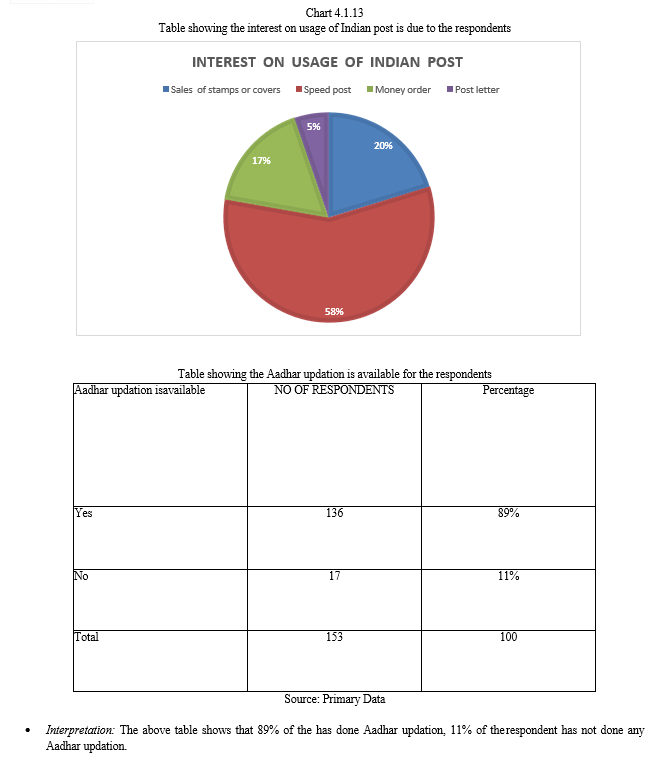
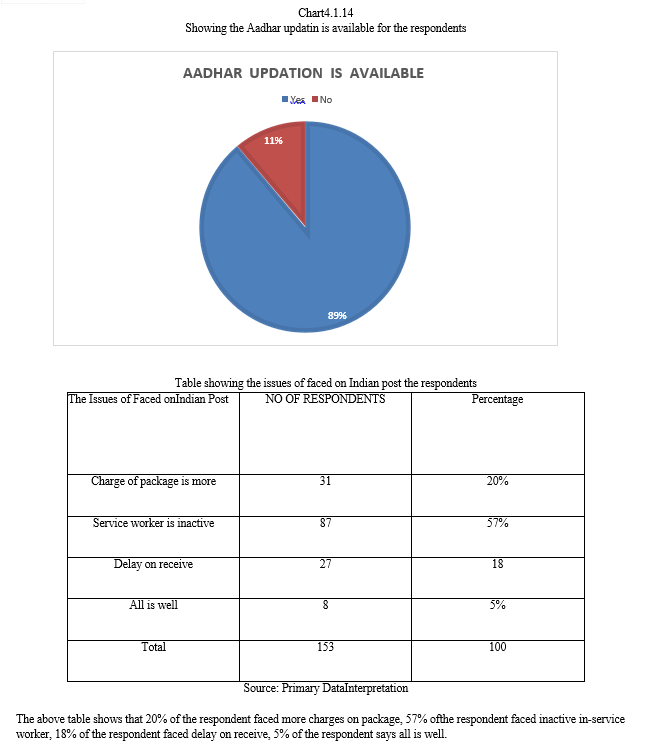
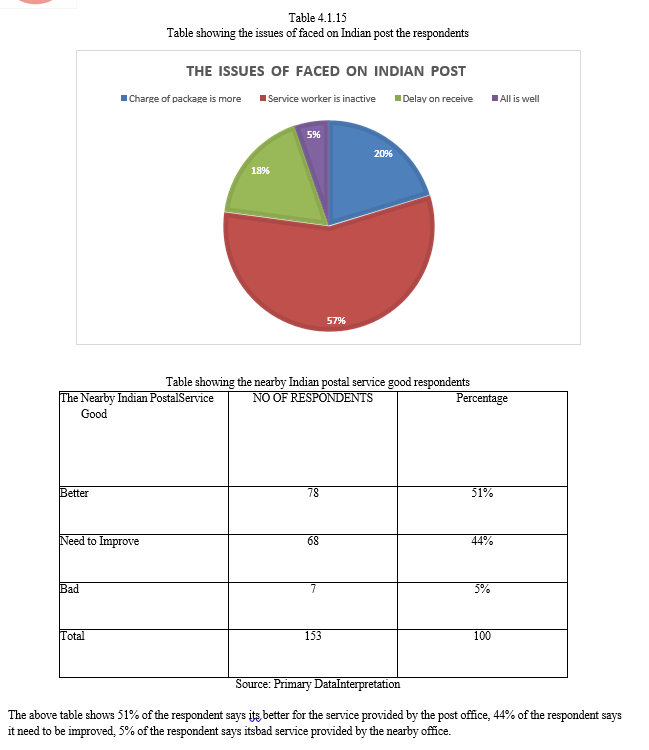

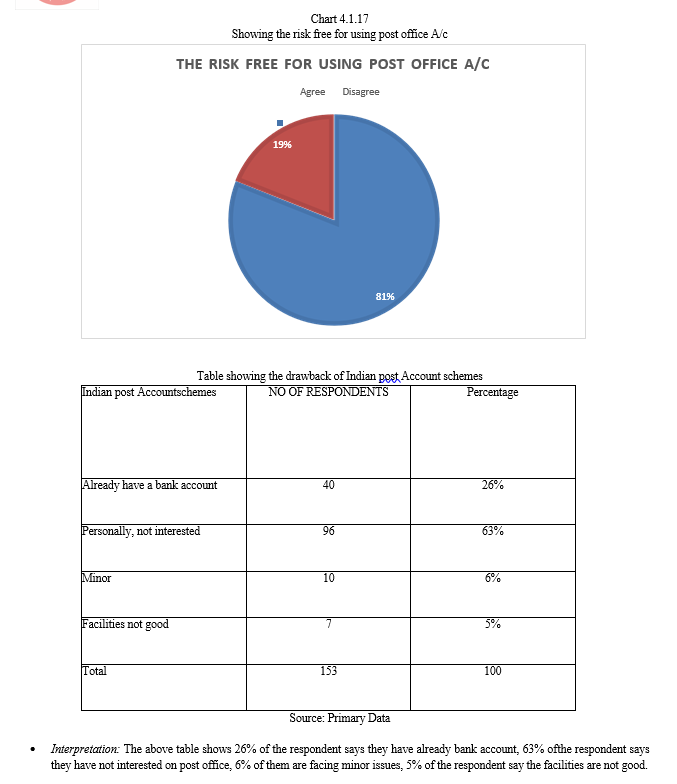
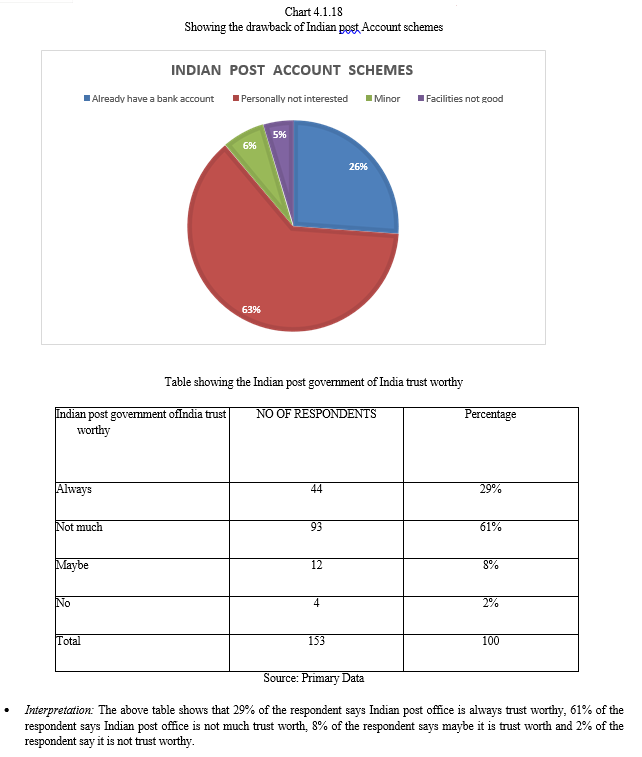
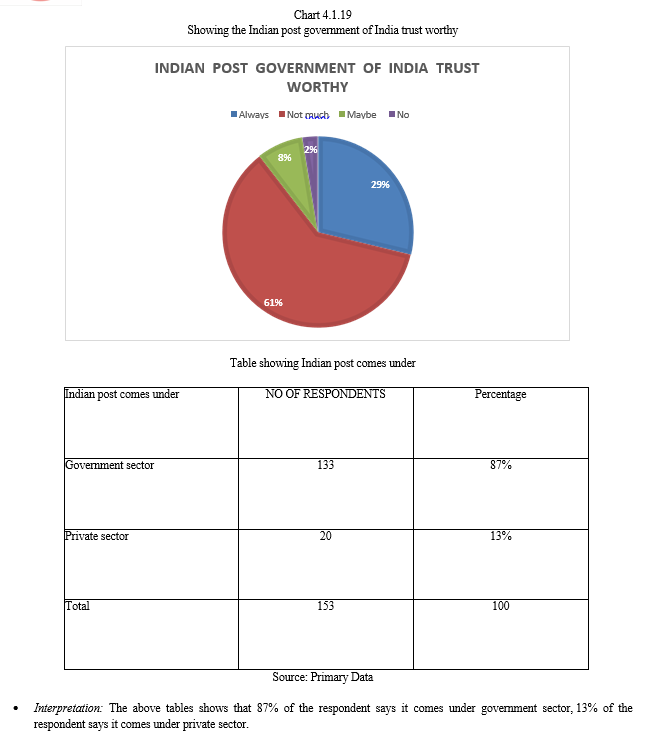
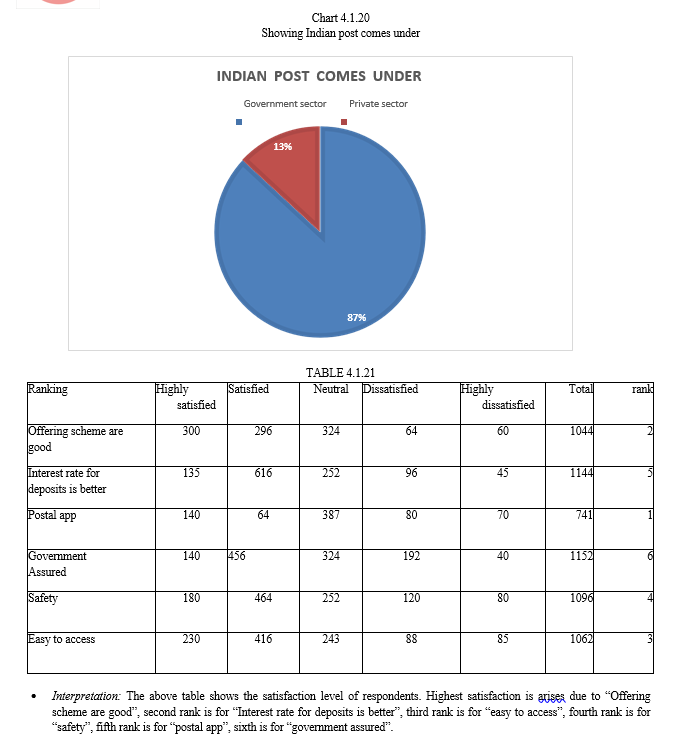
C. Weighted Average Method
Weighted average method is the mean of a set of numbers in which some elements of the set carry on more importance than others. The weighted average multiplies each data point by an weight and divides by the sum of the weights.
The weighted average formula is used to calculate value of a some set of numbers with different levels of relevance. The relevance of each number is called its weight. It weight should be represented as a percentage of the total relevancy. Therefore, all weights should be equal to 100% to 1.
TABLE 4.1.22
|
|
Highly satisfied |
Satisfied |
Neutral |
Dissatisfied |
Highly Dissatisfied |
Total |
Weighted average |
|
Scheme |
180 |
336 |
360 |
176 |
65 |
1117 |
7.30 |
|
Service |
90 |
528 |
306 |
208 |
45 |
1177 |
7.69 |
|
Interest |
55 |
352 |
477 |
288 |
45 |
1217 |
7.95 |
|
Convenience |
50 |
304 |
459 |
344 |
55 |
1212 |
7.92 |
|
Withdrawn method |
50 |
192 |
378 |
352 |
90 |
1062 |
6.94 |
|
Digitalization |
65 |
312 |
360 |
328 |
100 |
1165 |
7.61 |
- Interpretation: The above table show the weighted average of consumer satisfaction. Withdrawn method is highest satisfied level, second is for digitalization, third is for convenience, fourth is for interest, fifth is for service and sixth is for scheme.
V. ANNEXURE
Age
- Below 21
- 21-30
- 31-50
- Above 50
Gender
- Female
- Male
Occupation status
- Business
- Working professional
- Student
- Homemaker
Marital status
- Single
- Married
Type of area
- Rural
- Urban
- Semi urban
Through which medium are you aware of Indian post office?
- Advertisement
- Relatives
- Friends
- Other
Have you visited the post office nearby
- No
- Yes
How many days does Indian postal service takes to deliver?
- 1-2 days
- 1-3 days
- 1-4 days
Have you sent any package or speed post through the Indian post?
- Recently
- Few months
- Never
The tracking consignment facility of Indian post is?
- Easy to access
- Bad
- Moderate
Your interest on usage of Indian
- Post is due to
- Sale of stamps or covers
- Speed post
- Money order
- Post letter
Aadhaar updation is available in indian post
- Yes
- No
What is the issues you have faced on Indian post
- Charge of package is more
- Service worker is inactive
- Delay on receive
- All is well
Is your nearby Indian postal service good?
- Better
- Need to inprove
- Bad
Is it risk free for using post office A/c, other than back account
- Agree
- Disagree
What is the drawback of Indian post account schemes?
- Already have a bank account
- Personally not interested
- Minor
- Facilities not good
Is the Indian post government of India trust worthy?
- Always
- Not much
- Maybe
- No
Does Indian post comes under
- Government sector
- Private sector
Are you satisfies about postal services online and offline and way of interest on scheme
Highly satisfied satisfied neutral dissatisfied highly dissatisfied
Oferring scheme are good Interest rate for deposit are better Postal app
Government assures Safety
Easy to access
State your satisfaction level
Highly satisfied satisfied neutral dissatisfied highly dissatisfied
Scheme Service Interest Convenience
Withdraw method digitalization
Conclusion
A. Findings ? 35% of the respondents are for the age groups of 31-50 years ? 65% of the respondents are male. ? 43% of the respondents are working in professionals. ? 35% of the respondents are for the monthly in income of below 15000. ? 50% of the respondents member in the family are 4. ? 52% of the respondents are married. ? 64% of the respondents are from rural areas. ? 44% of the respondents get to know about the Indian post office through relatives. ? 76% of the respondents visited the nearby post office. ? 54% of the respondents 1-3 days Indian postal service takes deliver. ? 63% of the respondents have used the Indian post office few months back. ? 59% of the respondents are tracking consignment facilities are easy to access. ? 58% of the respondents are the reason the use Indian post for speed post. ? 89% of the respondents found Aadhar updation is available in Indian post. ? 57% of the respondents feels that service work are inactive. ? 51% of the respondents are need to improve nearby postal service. ? 81% of the respondents agreed the risk free for using post office account. ? 63% of the respondents personally not interested for the Indian post accounts scheme. ? 61% of the respondents are not trust worthy towards Indian post government of India. ? 87% of the respondents that Indian post comes under government sectors. B. Suggestions ? Postal services are economic compared to other competitors. There is a lack of professional attitude and competitive foresight. With the adoption of modern methods of providing services to more customers can be attracted. ? To Aid the raise of revenue generation capacity. The prices should be competitive. ? India Post offers variety of services to the customers at reasonable prices. But the customers are not aware of such services. The proper Advertisements need to be made by Department of Post. ? Indian Postal Service Department has to increase the productivity of employees because a similar nature of work makes an employee irritate and less productive. ? To train the employees to develop relationships with regular clients. ? Time is precious for everyone. With this motto, the customer service department should work so that there shall not be a long queue in any counter. ? Customer Friendly environment should be there in every counter. ? To improve the delivery services with respect to time such as delivery in 24 hours even for other than local areas. ? Marketing strategies need to be implemented for retaining the existing customers and to attract the new one. ? The Department of Post need to compare their performance with the competitors and revolutionary decisions need to be implemented promptly to bring back the Glory of the India Post and to become a market leader. C. Conclusion It can be concluded that Indian Postal service needs technological, social, cultural & economic change. The status of any organization depends upon its personality, perceptions of the customers and the quality of the services offered. As regards the service quality perceptions on post offices, the positive attitude is greater than the negative attitude. Coimbatore Head post office are satisfied with their respective Specifically respondents of Coimbatore district are satisfied with the safety from crime while handling with cash, response to complaints, awareness about the services available and availability of information at the post office. Though the functions of post offices are procedural and its services are based on government norms.
References
[1] https://en.wikipedia.org/wiki/India_Post [2] https://en.wikipedia.org/wiki/Postage_stamps_and_postal_history_of_India [3] https://www.ijmra.us/project%20doc/2018/IJMIE_OCTOBER2018/IJMRA-14498.pdf [4] https://shodhgangotri.inflibnet.ac.in/bitstream/123456789/2772/3/03_%20literature%20review.pdf [5] http://lib.unipune.ac.in:8080/jspui/bitstream/123456789/8222/9/09_chapterII.pdf [6] http://www.academia.edu [7] http://www.google scholer.com
Copyright
Copyright © 2023 Vimal V. This is an open access article distributed under the Creative Commons Attribution License, which permits unrestricted use, distribution, and reproduction in any medium, provided the original work is properly cited.

Download Paper
Paper Id : IJRASET52230
Publish Date : 2023-05-14
ISSN : 2321-9653
Publisher Name : IJRASET
DOI Link : Click Here
 Submit Paper Online
Submit Paper Online

